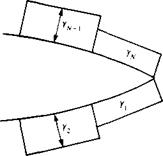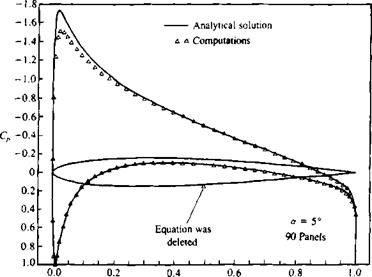Constant-Strength Vortex Method
The constant-strength vortex distribution was shown to be equivalent to a linear-strength doublet distribution (Section 10.3.2) and therefore is expected to improve the solution of the flow over thick bodies. However, this method is more difficult to use successfully compared to the other methods presented here. One of the problems arises from the fact that the self-induced effect (Eq.
(10.43) ) of this panel is zero at the center of the element (and the influence coefficient matrix, without a pivoting scheme, will have a zero diagonal). Also, when using the Kutta condition at an airfoil’s trailing edge (Fig. 11.23) the requirement that Уі + Yn = 0 eliminates the lift of the two trailing edge panels. Consequently, if N panels are used, then only N — 2 independent equations can be used and the scheme cannot work without certain modifications to the method. One such modification is presented in Ref. 5.1 (pp. 281-282) where additional conditions are found by minimizing a certain error function. In this section, we try to use an approach similar to the previous source and doublet methods, and only the specifications of the boundary conditions will be modified. We will follow the basic six-step procedure of the previous sections.
Selection of singularity element. Consider the constant-strength vortex element of Section 10.2.3, where the panel is based on a flat surface element. To establish a normal-velocity boundary condition based method, only the induced velocity formulas are used (Eqs. (10.39) and (10.40)):
 panel coordinates (11.44)
panel coordinates (11.44)
panel coordinates (11.45)

 Constant-strength vorticity panels near the trailing edge of an airfoil.
Constant-strength vorticity panels near the trailing edge of an airfoil.
Here, again, the velocity components (u, w)p are in the direction of the panel local coordinates, which need to be transformed back to the x-z system by Eq.
(11.23) .
This procedure can be included in an induced-velocity subroutine VOR2DC (where C stands for constant) that will compute the velocity (и, w) at an arbitrary point (x, z) due to the yth element:
(и, w) = VOR2DC (y,, z, Xjt zh xj+u z;+1) (11.46)
Discretization of geometry. In terms of generating the panel corner points (*;■ = 1. Zj=)> (*j=2, Zj=2), ■ ■ ■ , (xj=N+1, Zj=N+l), collocation points (jc, = 1, Z,=i). (*,=2. zi=2)> ■■■, (xi=N, z,=N), which are placed at the center of each panel, and the normal vectors n,-, the procedure of the previous section can be used (see Fig. 11.18).
Influence coefficients. A possible modification of the boundary condition that will eliminate the zero self-induced effect is to use an internal zero tangential- velocity boundary condition. This is based on Eq. (9.8), which states that inside an enclosed body Ф* = const. Consequently, the normal and tangential derivatives of the total potential inside the body are zero:
![]() <ЭФ* ЭФ* дп dl
<ЭФ* ЭФ* дп dl
In this particular case the inner tangential velocity condition will be used and at each panel:
(f/„ + u, + и>), • (cos or,, -sin or,) = 0 (11.47a)
In order to specify this condition at each of the collocation points (which are now at the center of the panel and slightly inside), the tangential velocity component is obtained by using Eq. (11.46). For example, the velocity at a collocation point 1, due to the yth vortex element is
(и, w)v = VOR2DC (Yj, xu zu Xj, zjt xj+l, zj+x) (11.48)
The influence coefficient at] is now defined as the velocity component tangent to the surface. Consequently, the contribution of a unit-strength singularity element j, at collocation point 1 is
а и = (и, w)v • (cos alt – sin or,)
where ax is the orientation of the panel (of the collocation point) as shown in Fig. 11.17. The general influence coefficient is then
йц = (и, w)ij • (cos ar„ – sin or,) (11.49)
By using this boundary condition the self-induced influence of the panel is
nonzero, and at the center of the panel, Eqs. (10.42) and (10.43) are recalled,
up(x, 0±) = ±| wp(x, 0±) = 0
Consequently, when і = j the influence coefficient becomes
al7 = – J (11.50)
Establish boundary condition (RHS). The free-stream tangential velocity component RHS, is found by
RHS, = —(£Л», Ж») • (cos <*,, -sin at) (11.51)
Note that in this case the free stream may have an angle of attack. The numerical procedure (using the double “DO loop” routine) for calculating the influence coefficients and the RHS, vector is the same as for the previous methods.
Solve Equations. Specifying the boundary condition for each (/ = 1 —* N) of the collocation points results in a set of algebraic equations with the unknowns y, 0 = 1 -* N). In addition the Kutta condition needs to be specified at the trailing edge:
Yi + У/v = 0 (11.52)
But now we have N + 1 equations with only N unknowns. Therefore, one of the equations must be deleted (e. g., the fcth equation) and by adding the Kutta condition the following matrix equation is obtained:
|
( |
![]()
![]() all ai2 ……………………..
all ai2 ……………………..
a21 a22 ……………………………….
![]() aN-1,1 aN-1,2 …………………..
aN-1,1 aN-1,2 …………………..
t 1 0 0 • • ■
Caculation of pressures and loads. Once the strength of the vortices y, is known, the velocity at each collocation point can be calculated using Eq.
(11.48) and the pressure coefficient can be calculated by using Eq. (11.18) (note that the tangential perturbation velocity at each panel is y,/2):

 Cp = –
Cp = –
The aerodynamic loads can be calculated by adding the pressure coefficient or by using the Kutta-Joukowski theorem. Thus the lift of the )th panel is
AT, = pQ^Yj Де,
where Дcy is the panel length. The total lift and moment are obtained by adding the contribution of each element:
L = £aL, (11.54)
/=i
N
M0 = X cos or) (11.55)
/=i
and the nondimensional coefficients can be calculated by using Eqs. (11.12) and (11.13).
Example 1 Symmetric thick airfoil at angle of attack. The above method is applied to the symmetric airfoil of Section 6.6. The computed pressure distribution is shown by the triangles in Fig. 11.24 and it agrees fairly well with the exact analytical results. The point where the computations disagree is where one equation was deleted. This can easily be corrected by a local smoothing procedure, but the purpose of this example is to highlight this problem. From the practical point of view it is better to use panels with a higher order (e. g., linear) vortex distribution or any of the following methods.
The sample student computer program that was used for this calculation is provided in Appendix D, Program No. 4.
|
X c FIGURE 11.24 Chordwise pressure distribution on a symmetric airfoil at angle of attack of 5° using constant-strength vortex panels. |












